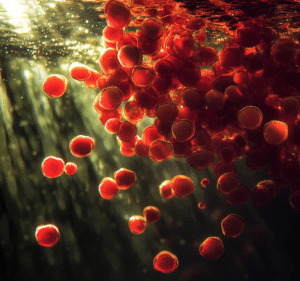Introduction
If you’re searching for a powerful antioxidant to enhance your health, Astaxanthin may be just what you need. This red pigment is naturally found in various marine organisms like salmon, shrimp, and crab, and can also be extracted from specific types of algae. In recent years, Astaxanthin has gained widespread attention for its exceptional health benefits, showing great potential in antioxidant protection and skin health improvement.
What is Astaxanthin?
Astaxanthin is a natural pigment belonging to the carotenoid family, a group of compounds widely present in plants and animals. Its chemical structure makes it a highly potent antioxidant. Studies have shown that Astaxanthin is up to 100 times stronger than beta-carotene and 6,000 times more effective than vitamin C at neutralizing singlet oxygen, a common free radical responsible for oxidative stress in the body . This makes it an incredibly effective agent in protecting cells from free radical damage, slowing the aging process, and reducing the risk of chronic diseases like cancer.

Key Benefits
Antioxidant Properties
One of the most notable characteristics of Astaxanthin is its powerful antioxidant properties. It neutralizes free radicals, slowing down the aging process and reducing the risk of cell damage. In a human clinical trial, participants who took 12 mg/day of Astaxanthin for eight weeks saw a significant reduction in oxidative stress biomarkers by 20% and improved antioxidant status by 40% . Research shows that Astaxanthin’s antioxidant activity is 500 times stronger than vitamin E and 6,000 times stronger than vitamin C, offering extensive protection against oxidative stress .
Anti-inflammatory Effects
In addition to its antioxidant properties, Astaxanthin also exhibits significant anti-inflammatory effects. It inhibits the production of inflammatory mediators, thereby alleviating various health problems caused by inflammation, such as arthritis and muscle fatigue. A 2010 study demonstrated that subjects taking 4 mg of Astaxanthin daily for eight weeks showed a reduction in C-reactive protein (CRP), a key marker for inflammation, by 35%, indicating lower systemic inflammation .
Eye Health and Skin Benefits
Astaxanthin is particularly beneficial for eye health. It can penetrate all layers of the eye, protecting the retina from light-induced damage and slowing vision deterioration. A 2005 study found that individuals who consumed 6 mg of Astaxanthin daily for four weeks experienced a 46% improvement in visual sharpness and reduced eye fatigue .
Moreover, Astaxanthin offers multiple skin benefits, including improving skin elasticity, reducing wrinkles, and preventing UV-induced damage. In a 2012 double-blind study, participants using both oral and topical Astaxanthin treatments for 12 weeks saw a 19% improvement in skin elasticity, a 35% reduction in wrinkles, and a 50% decrease in dryness .
How to Use
Astaxanthin can be consumed in various forms, including oral supplements and topical products. Common Astaxanthin supplements in the market are available in capsule and gummy forms, with a recommended daily dosage of 4-12 mg. For general antioxidant support, 4-8 mg daily is typically sufficient, while for more intensive benefits such as skin health or anti-inflammatory purposes, 8-12 mg may be recommended. In skincare, Astaxanthin is often added to creams and serums, with 2-5% concentration in formulations showing effective skin benefits .
Conclusion
In summary, Astaxanthin is a powerful antioxidant and anti-inflammatory agent with numerous health benefits. From protecting the eyes and skin to slowing the aging process, its multifunctional properties make it an excellent choice for nutritional supplementation. If you’re looking for a natural way to enhance your health, consider incorporating Astaxanthin into your daily routine. Whether through supplements or skincare products, Astaxanthin can provide robust support for both health and beauty.
References
- Ambati, R. R., et al. “Astaxanthin: Sources, Extraction, Stability, Biological Activities and Its Commercial Applications—A Review.” Marine Drugs, vol. 12, no. 1, 2014, pp. 128–152. https://www.ncbi.nlm.nih.gov/pmc/articles/PMC7023054/
- Fassett, R. G., & Coombes, J. S. “Astaxanthin: A Potential Therapeutic Agent in Cardiovascular Disease.” Marine Drugs, vol. 9, no. 3, 2011, pp. 447–465. https://www.ncbi.nlm.nih.gov/pmc/articles/PMC3083660/
- Naguib, Y. M. A. “Antioxidant Activities of Astaxanthin and Related Carotenoids.” Journal of Agricultural and Food Chemistry, vol. 48, no. 4, 2000, pp. 1150–1154. https://pubmed.ncbi.nlm.nih.gov/10775365/
- Park, J. S., et al. “Astaxanthin Decreased Oxidative Stress and Inflammation and Enhanced Immune Response in Humans.” Nutrition & Metabolism, vol. 7, 2010. https://pubmed.ncbi.nlm.nih.gov/21111828/
- Nagaki, Y., et al. “The Effect of Astaxanthin on Retinal Capillary Blood Flow in Normal Volunteers.” Journal of Clinical Therapeutics & Medicines, vol. 21, no. 7, 2005, pp. 537–542. https://pubmed.ncbi.nlm.nih.gov/16075560/
- Tominaga, K., et al. “Cosmetic Benefits of Astaxanthin on Humans Subjects.” Acta Biochimica Polonica, vol. 59, no. 1, 2012, pp. 43–47. https://www.sciencedirect.com/science/article/pii/S0022354917407747
- Higuera-Ciapara, I., et al. “Astaxanthin: A Review of its Chemistry and Applications.” Critical Reviews in Food Science and Nutrition, vol. 46, no. 2, 2006, pp. 185–196. https://www.tandfonline.com/doi/abs/10.1080/10408390591004111